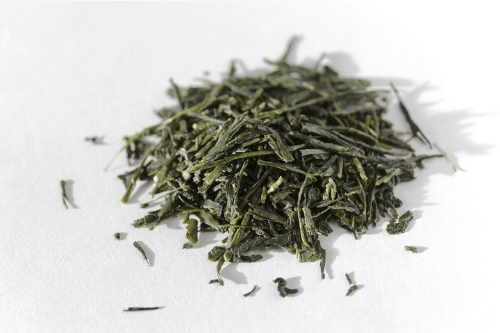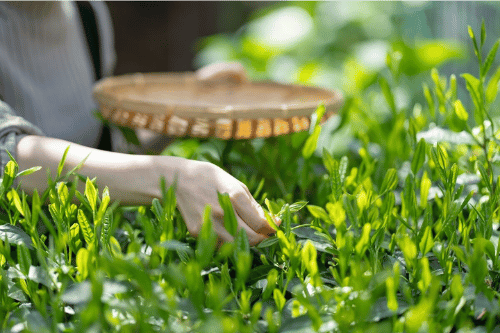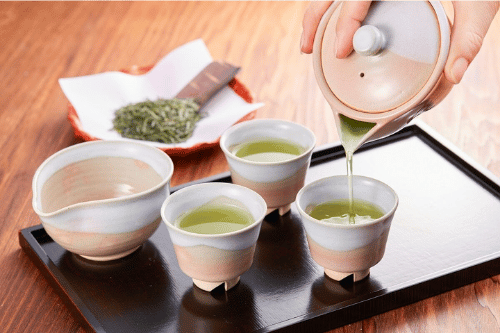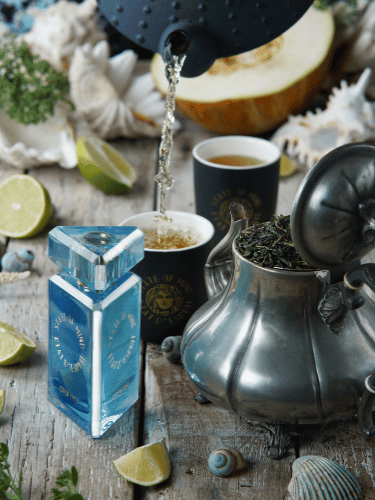New article at global perfume e-magazine fragrantica.com about Open Mind perfume.
By Elena Prokofeva
In my opinion, Open Mind is the most underrated perfume in the State of Mind tea collection. Due to its bright and fresh aquatic start, which lingers when tested on paper, it seems like one of those high-quality but unoriginal aquatic fresh scents. However, it has a completely different character.

If a typical fresh fragrance on an aquatic theme can be called extroverted, then Open Mind, despite its name, is introverted. It is more about personal comfort in the face of the elements than journeys across vast aquatic expanses. Although there is a lot of water in it, and it’s immediately clear that it’s very big. This is a sea with heavy waves crashing on the shore, agitated but not stormy, cool but not wintry… A sea where it’s uncomfortable to swim, but it’s pleasant to wander along the shore and breathe in its smell.
Open Mind‘s aquatic notes are simultaneously sweet (due to ozone notes) and salty, with a clear hint of seaweed. A note of melon juice adds freshness and sweetness to the sea but without discord; it is very restrained. Lotus’ delicate aroma provides additional moisture and sweetness, though I associate it more with fresh water than the sea.

However, there is nothing truly innovative in the aquatic part of Open Mind, although it can’t be called completely banal either. Apart from the aquatic part, everything else in Open Mind is interesting.
Beneath the aquatic notes and various shades of watery sweetness hide green, resinous, and woody notes: hinoki, cypress, juniper, and guaiac. The guaiac here is both sweet, with its characteristic gingerbread nuance, and salty, like a piece of driftwood tossed around by the waves for a long time, so that it has grown into seaweed and then lay on the shore for even longer, sparkling with crystals of dried salt under the sun. And even deeper, beneath the sharp and spicy salty woodiness, I feel a cozy leather base.
But the main element in Open Mind is tea. The entire line is inspired by tea, although a coffee-themed fragrance, Fanfarone Italiano, has recently been added. There is indeed tea in Open Mind. It’s black tea with a hint of smoke. Not a noble smoked Lapsang Souchong, but simply tea with a smoky note, brewed over a campfire by the sea. The tea is enveloping with a cozy aroma, as if protecting with its warmth from the cold, rhythmic splashing of the immense ocean.

However, the tea note I smell in Open Mind is not actually the tea the perfume is dedicated to. Gyokuro, which in Japan is called “precious dew” or “pearl drop”, has a quiet and completely different scent. Open Mind also conveys its aroma. It can be detected somewhere between the hinoki notes and the sea.

Various experiments have been conducted to obtain tea with an unusual, deeper, and more refined flavor!
To produce Gyokuro, tea bushes are covered to reduce sunlight exposure. Initially, bamboo structures were erected over the tea bushes, over which straw was spread, later replaced by dense mesh. This technique results in dark green leaves with a high chlorophyll content and lower tannin levels. The tea is harvested later since the leaves take longer to mature due to lack of light. To this day, the harvest from shaded cultivation is done by hand, making this tea very expensive. Shaded cultivation is used to produce Gyokuro, Kabusecha, Tencha, and Matcha: the result and flavor depend on the shading duration.


High-grade teas such as Gyokuro or Sencha are brewed using a special technique where every detail is taken into account, especially the water temperature. It is important not to exceed 65-75 degrees Celsius. Before pouring hot water directly onto the tea leaves, it is poured into the guests’ cups to cool down. The first infusion is the longest, and with each subsequent infusion, the tea’s flavor changes, becoming deeper and richer.

The Japanese seem to have achieved the ultimate level of aestheticism in their approach to tea. Of course, I cannot compare Chinese (older) and Japanese tea cultures to conclude which is more complex. But about what tea means to the Japanese, Okakura Kakuzo wrote in his famous Book of Tea in 1906. I will quote a large passage here. Those who do not want to read it can easily skip it, but for tea lovers like me, Okakura Kakuzo’s words are precious and resonate in the soul with quiet joy. After all, tea and perfumes are inseparably linked… Just like fragrances and Fragrantica!
“Tea began as a medicine and grew into a beverage. In China, in the eighth century, it entered the realm of poetry as one of the polite amusements. The fifteenth century saw Japan ennoble it into a religion of aestheticism — Teaism. Teaism is a cult founded on the adoration of the beautiful among the sordid facts of everyday existence. It inculcates purity and harmony, the mystery of mutual charity, the romanticism of the social order. It is essentially a worship of the Imperfect, as it is a tender attempt to accomplish something possible in this impossible thing we know as life.
The long isolation of Japan from the rest of the world, so conducive to introspection, has been highly favourable to the development of Teaism. Our home and habits, costume and cuisine, porcelain, lacquer, painting—our very literature—all have been subject to its influence. No student of Japanese culture could ever ignore its presence. It has permeated the elegance of noble boudoirs, and entered the abode of the humble. Our peasants have learned to arrange flowers, our meanest labourer to offer his salutation to the rocks and waters. In our common parlance we speak of the man “with no tea” in him, when he is insusceptible to the serio-comic interests of the personal drama. Again we stigmatise the untamed aesthete who, regardless of the mundane tragedy, runs riot in the springtide of emancipated emotions, as one “with too much tea” in him.
The outsider may indeed wonder at this seeming much ado about nothing. What a tempest in a tea-cup! he will say. But when we consider how small after all the cup of human enjoyment is, how soon overflowed with tears, how easily drained to the dregs in our quenchless thirst for infinity, we shall not blame ourselves for making so much of the tea-cup. Mankind has done worse. In the worship of Bacchus, we have sacrificed too freely; and we have even transfigured the gory image of Mars. Why not consecrate ourselves to the queen of the Camelias, and revel in the warm stream of sympathy that flows from her altar? In the liquid amber within the ivory-porcelain, the initiated may touch the sweet reticence of Confucius, the piquancy of Laotse, and the ethereal aroma of Sakyamuni himself.”

I have tried Gyokuro tea because I am generally curious about teas. However, I couldn’t appreciate it. For me, it is too refined a beverage. It seemed strange to me, slightly salty, and indeed slightly reminiscent of seaweed. Perhaps drinking Gyokuro only makes sense in Japan, and after a long journey, the tea changes? Maybe someday I will try proper Gyokuro in the right place, but it is unlikely that I will love it more than regular black tea.
In Open Mind, I still feel black tea, just black tea with a hint of smoke, drunk by the sea, hot tea by the cold sea… A familiar tea. And I am very happy about that. For me, the familiar and understandable tea note is more interesting than complex Gyokuro. Although it is here too: disguised as seaweed scent and salty freshness.


Open Mind is one of my favorite fragrances by State of Mind. And I sincerely recommend trying it to anyone who loves the sea and tea, but perhaps did not detect the tea in Open Mind during the first encounter. And although Open Mind is good any time of the year, I especially enjoy wearing it in the summer in the city. I love the illusions that perfumes create, and Open Mind gives me the illusion of the sea and a sense of calm. Of course, that calm is provided by the tea note I feel.
Published on fragrantica.com at 22/07/24